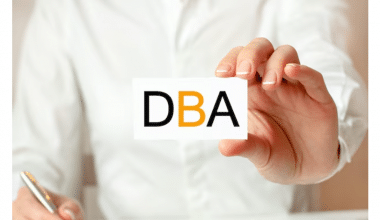As an entrepreneur or business owner, the need to present your ideas, desire, and demand in a written form is pertinent as it is the foundation and fundamental skill in professional communication. It is important to maintain a professional tone, clear communication, and proper formatting. In the modern world of business communication, writing a well-crafted business letter is an essential skill. There is a need to address the recipient, logically organize the letter, and incorporate appropriate language and etiquette. Writing effective business letters requires attention to detail, professionalism, and clear communication. Here, we’ll take a look at how to write a business letter. We’ll also see some ideas and examples to help guide yours.
What are Business Letters?
A business letter is a formal written communication between businesses or individuals within a business context. It is used for professional correspondence, conveying important messages, making requests, providing information, or resolving issues.
Business letters usually adhere to specific formats and conventions, including proper salutations, clear and concise language, and appropriate tone. They are often printed on company letterhead or professionally sent via email. Business letters can serve various purposes, such as making inquiries, submitting proposals, expressing gratitude, resolving complaints, or establishing and maintaining professional relationships. They are an essential tool in effective business communication.
Uses of Business Letter
There are different types of business letters. Each business letter has a specific purpose. It is important to pay attention to the format and language used to communicate effectively. Proper formatting includes a clear and concise heading that includes contact information and the date, a formal salutation and opening paragraph that clearly states the purpose of the letter, organized paragraphs that provide supporting details, and a professional closing with contact information and a signature.
Business letters are formal written documents used for communication in a professional setting. They are typically used to convey important information, make requests, provide updates, or professionally express gratitude. Business letters are a crucial form of written communication in the corporate world. They serve as a professional means of conveying important information, making requests, expressing gratitude, or resolving issues.
Proofreading is crucial to identify and correct any errors before sending the letter. By taking the time to review and revise the letter, individuals can ensure that it maintains a professional and respectable image.
Business letters encompass a variety of types, including inquiry letters, complaint letters, cover letters, thank you letters, recommendation letters, and sales letters. It also includes confirmation letters, resignation letters, proposal letters, request letters, follow-up letters, and introduction letters. Each type serves a distinct purpose and requires specific formatting, tone, and content to effectively convey information. It should also express gratitude, make requests, provide endorsements, or address concerns professionally.
Types of Business Letters
#1. Sales Letters
These letters aim to promote a product or service to potential customers. They highlight the benefits, features, and value of the offering and persuade recipients to make a purchase or take action.
#2. Inquiry Letters
These letters are used to seek information or clarification from a company or individual. They may inquire about products, services, pricing, availability, or any other relevant details.
#3. Complaint Letters
When customers encounter issues with products or services, they may write complaint letters to express their dissatisfaction and seek a resolution. These letters outline the problem, provide details, and request appropriate action.
#4. Recommendation Letters
These letters are written to vouch for someone’s skills, abilities, character, or qualifications. They are often requested by individuals applying for jobs, scholarships, or other opportunities as a means of providing support and validation.
#5. Cover Letters
When applying for a job, a cover letter accompanies the resume. It introduces the applicant, explains their interest in the position, highlights relevant skills and experiences, and demonstrates why they are a strong candidate.
#6. Thank-You Letters
These letters express gratitude and appreciation to clients, customers, business partners, or colleagues. They are sent to acknowledge support, assistance, or a positive business relationship.
#7. Business Proposal Letters
These letters are used to present a formal business proposal to potential clients, investors, or partners. They outline the project or partnership scope, objectives, benefits, and terms clearly and persuasively.
#8. Introduction Letter
Used to introduce oneself, a company, or a new product or service to potential clients or business partners.
#9. Follow-Up Letter
Sent after a meeting, interview, or business interaction to express continued interest, reinforce key points, or address any outstanding issues
#10. Confirmation Letter
Used to confirm an appointment, meeting, order, or any other arrangement.
#11. Resignation Letter
Written to inform an employer of the decision to leave a job and provide notice of the intended departure date
Examples of Business Letters
Here are a few examples of business letters:
#1. Business Proposal Letter
[Name] [Address] [City, State, ZIP] [Email Address] [Phone Number] [Date] [Recipient’s Name] [Recipient’s Title] [Company Name] [Company Address] [City, State, ZIP]Dear [Recipient’s Name],
I am writing to present a business proposal for a potential partnership between our companies. [Introduce the purpose and context of the proposal]. Our extensive market research indicates that collaborating could result in [mention specific benefits or opportunities].
In this proposal, we have a list of the key details of the partnership, including [briefly mention key points]. Additionally, we have included a financial projection and timeline for implementation.
We believe that this partnership has the potential to [state desired outcomes]. We would be grateful for the opportunity to discuss this proposal further and explore the possibility of working together.
Please find attached our complete business proposal document. We look forward to your favorable response.
Thank you for your time and consideration.
Sincerely,
[Name] [Title] [Company Name]#2. Job Application Cover Letter
[Name] [Address] [City, State, ZIP] [Email Address] [Phone Number] [Date][Recipient’s Name]
[Recipient’s Title]
[Company Name]
[Company Address]
[City, State, ZIP]
Dear [Recipient’s Name],
I am writing to apply for the [Position Title] at [Company Name], as advertised on [Source of Job Advertisement]. [Introduce yourself briefly and state your interest in the position].
I have [mention relevant qualifications, skills, and experiences] that make me an ideal candidate for this role. [Highlight specific achievements or projects]. So, I am confident that my skills and expertise align with the requirements in the job description.
Enclosed is my resume, which provides additional details about my qualifications. I would greatly appreciate the opportunity to discuss my application further and demonstrate how I can contribute to [Company Name]’s success.
Thank you for considering my application. I look forward to the possibility during the interview.
Sincerely,
#3. Thank You Letter
[Date]
[Recipient’s Name]
[Recipient’s Title]
[Company Name]
[Company Address]
[City, State, ZIP]
Dear [Recipient’s Name],
I am writing to express my sincere gratitude for [mention the reason, such as attending a meeting, providing assistance, etc.]. [Add a personal touch or specific details about the interaction].
Your [support/knowledge/assistance] has been invaluable and has made a great contribution to [mention positive impact or outcomes]. I am truly grateful for your expertise and willingness to [mention any specific actions or advice received].
I wanted to take a moment to express my appreciation and acknowledge your significant contribution. It is through collaborative efforts and partnerships like ours that we can achieve success.
Once again, thank you for your support, and I look forward to the possibility of working together in the future.
Sincerely,
How to Write a Business Letter
Writing effective business letters requires attention to detail, professionalism, and clear communication.
- Begin with the sender’s information, including name, title, company name, address, phone number, and email address.
- Include the date of writing the letter.
- Provide the recipient’s information, such as name, title, company name, and address.
- Start with a formal salutation, addressing the recipient appropriately.
- Introduce the letter with a concise statement of the purpose and any relevant context.
- In the body of the letter, elaborate on the purpose, using clear and concise language.
- Divide the letter into paragraphs for better organization and readability.
- Close the letter by summarizing the main points and expressing willingness to discuss further.
- End with a polite and professional closing salutation.
- Consider mentioning any enclosures or attachments, if applicable.
- Proofread the letter thoroughly for grammar, spelling, and formatting errors.
- Ensure the letter maintains a professional tone and adheres to proper formatting guidelines.
- Deliver the letter through the appropriate medium (email, printed letter, etc.) with the necessary enclosures, if any.
What are the Types of Business Letters?
Types of Business Letters include:
- Sales Letter
- Inquiry Letters
- Complaint Letters
- Recommendation Letters
- Cover Letters
- Thank-You Letters
- Business Proposal Letters
- Introduction Letter
- Follow-Up Letter
- Confirmation Letter
- Resignation Letter
What are Examples of Business Letters?
Examples of business letters include:
- Inquiry letters for requesting information.
- Complaint letters for expressing dissatisfaction.
- Cover letters for accompanying job applications.
- Thank you letters for expressing gratitude.
- Recommendation letters for endorsing someone’s abilities.
- Sales letters for promoting products/services.
- Confirmation letters for verifying agreements.
- Resignation letters for notifying job departure.
- Proposal letters for presenting offers.
- Request letters for seeking permission or assistance.
How Do You Write a Business Letter?
To write a business letter, follow these general steps:
- Determine the purpose of the letter and identify your audience.
- Research the topic and gather any necessary information to include in the letter.
- Choose a professional letter format and use a clear, concise heading that includes your contact information and the date.
- Use a formal salutation and opening paragraph that clearly states the purpose of the letter.
- Organize your letter into clear, concise paragraphs that provide supporting information and details.
- Use a professional tone throughout the letter, avoiding overly casual language or slang.
- Close the letter with a summary of the key points and a call to action, followed by a formal closing and your signature.
- Proofread and edit the letter carefully for grammar and spelling mistakes.
What are the 2 Common Formats for a Business Letter?
Two common formats for a business letter are block format and indented format.
- Block format is the most common, where the entire letter is left-justified and single-spaced, with each paragraph starting on the left margin.
- The indented format is less common and has each paragraph indented at the beginning.
Both formats are acceptable for professional correspondence, so the choice between the two depends on personal preference and the requirements of the specific context.
What are the 5 Parts of a Business Letter?
The five parts of a business letter are as follows:
- Heading: The heading includes the writer’s contact information (name, address, phone number, and email) and is typically positioned at the top of the letter. It may include a reference number.
- Date: The date indicates when the letter is written.
- Inside Address: The inside address contains the recipient’s contact information, including their name, title, company, and address.
- Salutation: The salutation is the formal greeting used to address the recipient.
- Body: The body of the letter is where the main message or content is written.
Conclusion
To write an effective business letter, it is important to follow a few key steps. First, you need to determine the purpose of the letter and identify your audience. This will help you understand how to structure the letter and what tone and language to use. Next, you should research the topic and gather any necessary information to include in the letter.
When drafting the letter, it is important to use a professional tone and format. Begin with a heading that includes your contact information and the date, followed by a formal salutation and an opening paragraph that clearly states the purpose of the letter. The body of the letter should be organized into clear, concise paragraphs that provide supporting information and details. Throughout the letter, be sure to maintain a polite tone, and avoid using slang or overly casual language. Finally, close the letter with a summary of the key points and a call to action, followed by a formal closing and your signature. To ensure that your business letter is effective, it is important to proofread and edit carefully, checking for grammar and spelling errors.
Related Articles
- HOW TO WRITE BUSINESS REPORTS: Detailed Guide
- HOW TO WRITE A LETTER OF AGREEMENT: Tips & Guide
- LETTER OF INTEREST VS COVER LETTER: Key Differences
- WHAT IS SALES PROSPECTING? Techniques, Templates & Software Solutions
- HOW TO WRITE A PROFESSIONAL LETTER: Free Guide & Tips To Know






